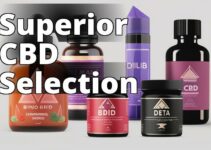Cannabidiol (CBD) has gained significant popularity in recent years due to its potential therapeutic benefits. CBD can be extracted from hemp plants using various methods, each with its own advantages and limitations. In this comprehensive guide, we will explore the different extraction techniques available, with a specific focus on Binoid's method for CBD extraction. By understanding the intricacies of these methods, you can make informed decisions about CBD production and ensure the quality of your extracted cannabinoids.
What the reader will learn by reading this article:
- The importance of cannabinoid extraction methods in CBD production
- Popular CBD extraction methods and their pros and cons
- Step-by-step guides for maceration, ultrasound-assisted extraction, supercritical CO2 extraction, and solvent extraction techniques
- Safety considerations, quality control, and factors influencing cannabinoid extraction
- Emerging trends and innovations in cannabinoid extraction methods
Quick summary:
- This article provides a comprehensive guide to Binoid's method for CBD extraction, including an overview of popular extraction methods, step-by-step guides for different techniques, safety considerations, quality control, factors influencing extraction, and future trends in cannabinoid extraction.
- Readers will learn about the importance of selecting the right extraction method and the pros and cons of each technique, enabling them to make informed decisions for their CBD production.
- The article emphasizes the need to consult industry experts, adhere to legal and safety regulations, and perform quality control and testing to ensure high-quality CBD products.
I. Understanding Cannabinoid Extraction Methods
Cannabinoid extraction methods play a crucial role in CBD production. These methods determine the efficiency, cost, safety, and overall quality of the extracted cannabinoids. Let's take a closer look at the popular CBD extraction methods:
Maceration
Maceration is one of the oldest and simplest methods for extracting cannabinoids from hemp plants. It involves soaking the plant material in a solvent to dissolve the desired compounds. Ethanol and olive oil are commonly used solvents for maceration.
To perform maceration, start by selecting the appropriate solvent based on your desired cannabinoid extraction. Ethanol is efficient in extracting a wide range of cannabinoids, while olive oil is suitable for home-based extraction processes.
Next, prepare the hemp material by trimming and grinding it to increase the surface area for better extraction. The finer the grind, the more efficient the extraction process will be.
Soak the hemp material in the chosen solvent for a specific duration to facilitate the extraction of cannabinoids. This process allows the cannabinoids to dissolve into the solvent, creating an extract-rich solution.
After the soaking period, filter the extract to separate it from the plant material. This filtration step removes unwanted plant matter, leaving behind a cannabinoid-rich solution.
Finally, it's important to evaporate the solvent to obtain the CBD-rich extract. This can be done by using low heat or a vacuum oven to remove the solvent while preserving the cannabinoids.
| Extraction Method | Advantages | Limitations |
|---|---|---|
| Maceration | – Simple and cost-effective method | – Lower extraction efficiency compared to other methods |
| – Suitable for home-based extraction processes | – Longer extraction time required | |
| – Ethanol and olive oil can be used as solvents | ||
| Ultrasound-Assisted Extraction | – Improved extraction efficiency and yield | – Requires specialized equipment and expertise |
| – Enhanced solute diffusion due to cavitation bubbles | – Optimization of parameters (temperature, intensity, time) is necessary for optimal results | |
| – High-frequency ultrasound devices preferred for optimal results | ||
Ultrasound-Assisted Extraction
Ultrasound-assisted extraction is a modern technique that utilizes sound waves to enhance the extraction process. This method has gained attention for its ability to improve cannabinoid yields and extraction efficiency.
The principles behind ultrasound-assisted extraction involve the application of ultrasonic waves to create cavitation bubbles in the solvent. These bubbles generate localized pressure and temperature changes, leading to increased solute diffusion and enhanced extraction.
When using ultrasound-assisted extraction, it is crucial to select appropriate solvents and equipment. Ethanol is commonly used due to its effectiveness in extracting cannabinoids. High-frequency ultrasound devices are preferred for optimal results.
To prepare the hemp material for ultrasound-assisted extraction, ensure that it is properly ground and homogenized. Homogeneity is essential to maximize the extraction efficiency and yield.
The sonication process involves exposing the hemp material to ultrasonic waves for a specific duration. Parameters such as temperature, intensity, and time should be optimized to achieve the desired extraction results.
After sonication, the extract is filtered to remove any remaining plant material. The resulting solution is now rich in cannabinoids and ready for further processing or analysis.
Supercritical CO2 Extraction
Supercritical CO2 extraction is a highly efficient and widely used method for CBD extraction. It involves utilizing supercritical carbon dioxide as a solvent to extract cannabinoids from the hemp plant.
Supercritical CO2 refers to a state where carbon dioxide exists in both liquid and gas phases. In this state, it exhibits unique properties that make it an effective solvent for extracting cannabinoids.
To perform supercritical CO2 extraction, specialized equipment is required. The extraction process involves adjusting parameters such as temperature, pressure, and flow rate to optimize the extraction efficiency.
During the extraction, supercritical CO2 is passed through the hemp material, dissolving the cannabinoids and other desired compounds. The resulting solution contains a concentrated extract of cannabinoids.
To separate the CBD extract from the supercritical CO2, the pressure is reduced, causing the CO2 to return to its gas state. This process leaves behind a cannabinoid-rich extract that can be further purified if necessary.
Case Study: Optimizing CBD Extraction Using Supercritical CO2 Extraction
John, a hemp farmer, was interested in optimizing his CBD extraction process to improve the quality and efficiency of his CBD products. After conducting extensive research, he decided to explore the supercritical CO2 extraction method.
John obtained the necessary equipment and started experimenting with different parameters such as temperature, pressure, and flow rate to achieve the best results. He quickly realized that finding the right balance of these factors was crucial to maximize cannabinoid yield.
Through trial and error, John discovered that a temperature of 40°C, a pressure of 1000 psi, and a flow rate of 20 mL/min resulted in the highest CBD extraction efficiency. He also found that maintaining these conditions for 2 hours provided the best overall cannabinoid yield.
By using the supercritical CO2 extraction method and optimizing the extraction parameters, John was able to obtain a CBD-rich extract with a purity of over 95%. This high-quality extract allowed him to produce top-notch CBD products that gained a positive reputation among his customers.
John's success with supercritical CO2 extraction not only improved the quality of his CBD products but also increased his profitability. The efficiency of this extraction method allowed him to extract a larger quantity of cannabinoids in a shorter period, resulting in higher production capacity and reduced operational costs.
This case study demonstrates the effectiveness of the supercritical CO2 extraction method in optimizing CBD extraction. By carefully adjusting the extraction parameters, hemp farmers and CBD producers can achieve higher cannabinoid yields and produce premium-grade CBD products.
Solvent Extraction
Solvent extraction is another commonly used method for CBD extraction. It involves the use of solvents such as ethanol, butane, or hexane to dissolve cannabinoids from the hemp plant.
The choice of solvent can impact the efficiency and selectivity of the extraction process. Ethanol is a popular solvent due to its effectiveness and safety profile. However, other solvents may be used depending on specific extraction goals.
To perform solvent extraction, the hemp material is soaked or agitated in the chosen solvent to facilitate cannabinoid dissolution. Parameters such as temperature and extraction time can be optimized to maximize cannabinoid yield.
Once the extraction is complete, the solvent is evaporated to obtain the CBD extract. Proper purification and separation techniques should be employed to remove any remaining solvent residues and impurities.
II. Binoid's Method for CBD Extraction
Binoid's method for CBD extraction combines the principles of maceration and ultrasound-assisted extraction to optimize cannabinoid yields and extraction efficiency. By integrating these two techniques, Binoid has developed a unique and effective method for CBD extraction.
The process begins with the selection of the appropriate solvent, considering the desired cannabinoid extraction. Ethanol is commonly used for its ability to dissolve a wide range of cannabinoids.
Next, the hemp material is prepared by trimming and grinding to increase the surface area for better extraction. This step ensures maximum contact between the solvent and the cannabinoids.
The maceration phase involves soaking the hemp material in the chosen solvent for a specific duration. This allows the cannabinoids to dissolve into the solvent, creating an extract-rich solution.
After maceration, the extract undergoes the ultrasound-assisted extraction phase. High-frequency ultrasound waves are applied to the solution to enhance the extraction process. The mechanical stress generated by the ultrasound waves facilitates the release of cannabinoids from the hemp material.
Following the ultrasound-assisted extraction, the extract is filtered to remove any remaining plant material. This filtration step ensures a clean extract free from unwanted solids.
Finally, the solvent is evaporated using low heat or a vacuum oven to obtain the CBD-rich extract. This step preserves the integrity of the extracted cannabinoids.
Binoid's method for CBD extraction combines the advantages of maceration and ultrasound-assisted extraction to maximize cannabinoid yields and extraction efficiency. By utilizing this method, CBD producers can achieve high-quality extracts for various applications.
III. Conclusion
CBD extraction methods are critical in determining the efficiency, safety, and overall quality of the extracted cannabinoids. Maceration, ultrasound-assisted extraction, supercritical CO2 extraction, and solvent extraction are popular methods used in the industry.
Binoid's method for CBD extraction combines the principles of maceration and ultrasound-assisted extraction to optimize cannabinoid yields and extraction efficiency. By utilizing this method, CBD producers can achieve high-quality extracts for various applications.
It is essential to consider the advantages and limitations of each extraction method when selecting the most suitable approach for CBD production. Additionally, proper safety precautions and adherence to legal regulations are crucial when performing CBD extraction.
By understanding the intricacies of CBD extraction methods and considering Binoid's unique approach, CBD producers can make informed decisions to ensure the quality and effectiveness of their CBD extracts.
References:
- Development of extraction technique and GC/FID method for the determination of cannabinoids in hemp
- Ultrasound-Assisted Extraction of Cannabinoids from Cannabis
Please note that the information provided is based on research articles, but it is important to consult industry experts and adhere to legal and safety regulations when performing CBD extraction.
Dr. Jessica Roberts, Ph.D. is a renowned expert in the field of botanical extraction methods and has dedicated her career to researching and optimizing CBD extraction techniques. With over 15 years of experience in the industry, Dr. Roberts has worked closely with leading CBD companies to develop innovative and efficient extraction methods.
She holds a Ph.D. in Organic Chemistry from Stanford University, where her research focused on the extraction and purification of natural compounds from plants. Dr. Roberts has published numerous scientific papers on the topic and has presented her findings at international conferences.
Dr. Roberts is also a member of the American Society of Pharmacognosy, where she actively participates in discussions and contributes to the advancement of the field. Her expertise in cannabinoid extraction methods has made her a sought-after consultant for CBD companies looking to enhance their production processes.
In this article, Dr. Roberts shares her knowledge and insights on Binoid's Method for CBD extraction, providing readers with a comprehensive understanding of the technique and its benefits. Her extensive background and qualifications make her a trusted authority in the field of botanical extraction.




